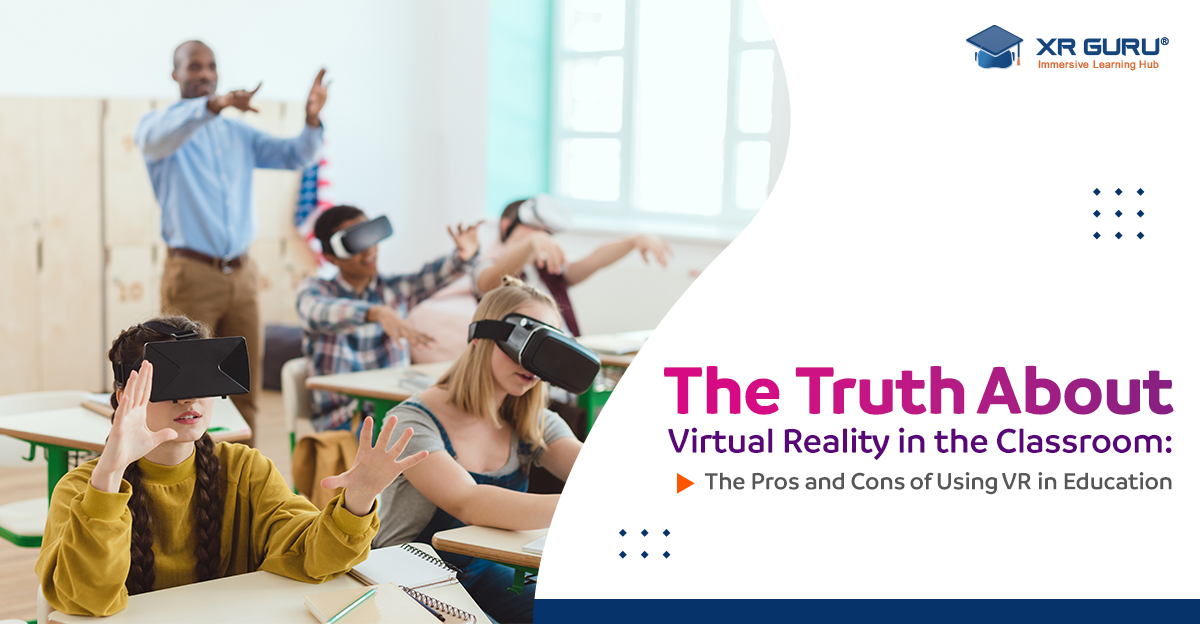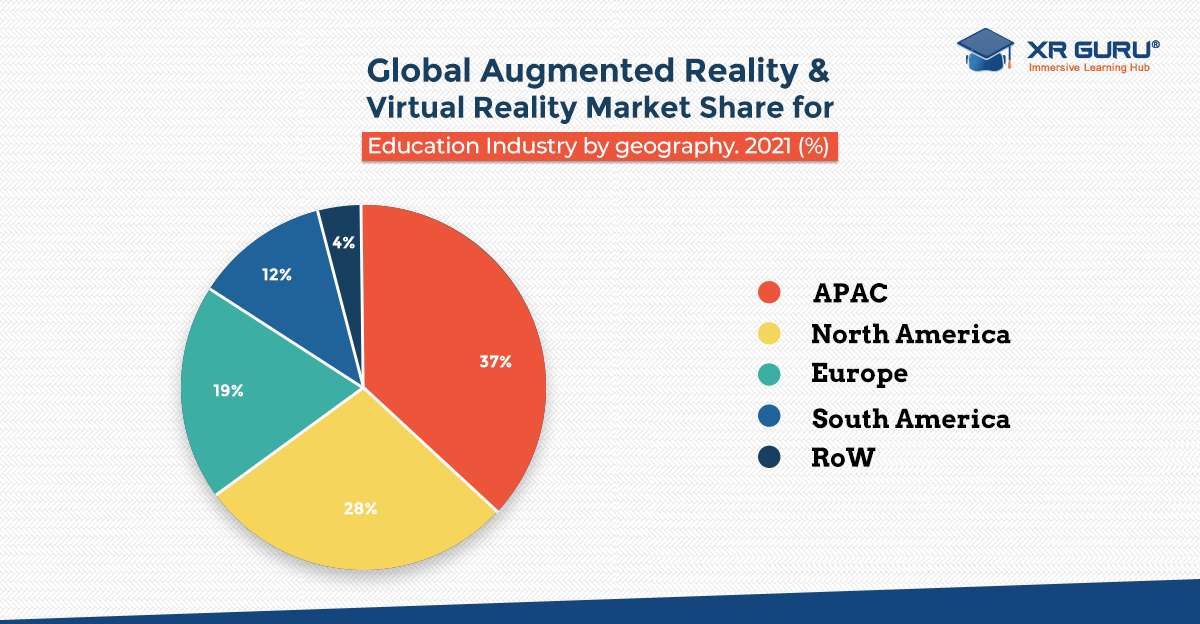
Is Virtual Reality (VR) technology the new buzz in the education sector? Can VR really enhance our teaching methods and make them more productive?
Many have hopped on the VR bandwagon, but it is difficult to cut through the hype to find the facts on VR adoption, effects, and the impact it can have on students.
Do you want to learn the truth about Virtual Reality in classrooms?
On May 19, 2022, at 11 am EST, XR Guru is conducting a webinar on "The Truth About Virtual Reality in the Classroom." This webinar will discuss the benefits of adopting VR in classrooms and the drawbacks of VR learning.
Join us to get valuable insights on virtual reality education.
Here is an overview of our blog:
-
1. What is Virtual Reality?
-
2. How Can VR Improve Education?
-
3. The Current State of VR in Education
-
4. Advantages of Using Virtual Reality in the Classroom
-
a. Visualized Learning
-
b. Drives Student Engagement
-
c. Does Not Feel Like Work
-
d. Offers a Memorable Learning Experience
-
e. Safe, Practical Learning Approach
-
f. Fosters Creativity and Imagination
-
g. Gamified Learning - Learn by Playing
-
h. Nullifies Language Barrier
-
5. Disadvantages of Using Virtual Reality in the Classroom
-
a. Downgrades Human Connection
-
b. Lack of Flexibility
-
c. Risk of Addiction
-
d. VR Can be Expensive
-
e. Health Issues
-
6. Explore Immersive Education with Virtual Reality
1. What is Virtual Reality?
Virtual reality is a computer-generated environment that alters the user's perception and allows users to interact with a simulated 3D environment using devices such as VR headsets or gloves embedded with sensors.
2. How can VR Improve Education?
Imagine teaching your students about ancient Roman civilization and taking a peek at how the Colosseum looked back then or taking your learners on a trip to the moon. Virtual reality in education makes it possible without ever leaving the classroom.
Virtual reality can improve education by providing students with a memorable learning experience that would otherwise not be possible. VR experiences have the power to engage and spur students' creativity. VR also makes it easier for teachers to explain complex concepts and monitor or track the learning activities.
3. The Current State of VR in Education
Virtual reality is showing promising growth in the education sector. In fact, stats show that the AR & VR education market size is projected to reach $22.4 billion by 2027, growing at a Compounded Annual Growth Rate (CAGR) of 14.6% from 2022-to 2027.

Many educational institutions are starting to realize the immense potential of VR in learning. The school and college sector is the fourth largest investor in VR technology. Both teachers and parents are excited by the potential of VR-based education programs. A survey shows that 62% of parents believe that investing in VR will provide engaging educational experiences for their children.
4. Advantages of Using Virtual Reality in the Classroom
a. Visualized Learning
Virtual reality offers powerful visualizations that are impossible in a traditional classroom setup. Humans are visual learners, and our brains process visuals faster than textual content. Immersive VR visuals let students explore different perspectives and contribute to a more engaging educational experience. The traditional methods can never match the visuals offered by VR. Looking at 2D diagrams in textbooks is not as beneficial as using VR simulations. For instance, learners can look at a 3D model of the human brain and study each part of the brain in detail.
b. Drives Student Engagement
Do you know the most common problem faced by teachers today? It is the diminishing attention span of students. Students lose interest quickly and are distracted easily. Using VR in classrooms assures that students are fully immersed in the lessons and ensures there is no room for distraction. Engaging VR simulations, graphics, and gamified lessons stimulate students' creative thinking and bring in an element of fun, so learning new information does not feel tiresome or boring.
c. Does Not Feel Like Work
Let us be honest for a moment; wearing a VR headset and watching interactive content unfold before your eyes do not feel like hard work. No matter what age students are, they love to watch something rather than read it from a textbook. With students being more exposed to technology, they will be interested in exploring VR-based courses. Learning new information through immersive visuals and 360° videos makes education fun and motivates children to learn more topics.
d. Offers a Memorable Learning Experience
Textbook-based lessons have been the go-to means for traditional education, but they can still be improved. The immersive nature of VR content makes for a more memorable learning experience. The experience that VR-based courses provide is unparalleled in learning. In some cases, just 2D images are not sufficient to explain concepts. VR comes in handy in this situation, as VR simulations and virtual field trips can help students explore things themselves.
For example, how does "traveling back in time" to meet the dinosaurs sound? Thanks to VR technology, we can 'teleport' learners to inaccessible locations and 'time travel' to the past.
e. Safe, Experiential Learning Approach
Some schools do not have enough space or budget to construct labs. Adopting virtual reality in education promotes a hands-on learning experience and offers a safe space for students to practice their skills. With virtual reality, learners can practice experiments that would generally be dangerous in a classroom setting. VR enables us to conduct experiments without the fear of harming students or equipment. For example, students can practice risky training activities such as medical surgeries, heavy machinery training, fire drills, etc.
f. Fosters Creativity and Imagination
Adopting virtual reality in education nurtures students' creativity and sparks their imagination. Instead of looking at an image, learners can be immersed in a VR simulation and develop interest based on interactions in the virtual environment. The immersive experience of VR stimulates disruptive thinking and inspires students to find innovative solutions to different problems.
g. Gamified Learning - Learn by Playing
Making students sit in one place for a prolonged period is increasingly difficult for teachers. Kids these days are more focused on playing video games. Virtual reality in education brings gaming elements to learning. Gamified learning helps teachers to hold learners' attention and makes it easy to explain complex concepts.
h. Nullifies Language Barrier
The language barrier is often a big problem for students who want to study abroad. If you want to study in a foreign country, you have to understand and speak the local language. With virtual reality, multiple languages can be implemented in the software. Thus, language will not be a hindrance to a student's education plans.
2. Disadvantages of Using Virtual Reality in the Classroom
Although using virtual reality in education has several benefits, it also has a few drawbacks.
a. Downgrades Human Connection
In the current state of virtual reality applications, users are mostly connected to software, which can limit the human connection. A traditional classroom setup relies on personal human interactions and interpersonal communication. In VR-based courses, it is just learners and software, and this can deteriorate the relationship between students and instructors.
b. Lack of Flexibility
The lack of flexibility in VR-based classrooms can be a disadvantage for students, as education is not a fixed activity, and each student learns at a different pace. In a conventional classroom, learners have the liberty to stop the lesson at any time and ask their teachers queries. If learners are using VR software that is programmed to work in a particular way, they may not be able to stop the lessons midway to get answers to their questions.
c. Risk of Addiction
The possibility of students getting addicted to the virtual world does exit. It is possible that VR lessons could have an impact like video game addiction. If what learners experience in the virtual world is better than the real-world experience, there is a chance of them becoming addicted to the virtual world.
d. VR Can be Expensive
Cutting-edge technology can be costly. VR in education is still in its development phase, so VR equipment and software development are expensive. However, VR technology is growing across industries, so the technology will definitely become less expensive in the future.
e. Health Issues
One of the important reasons people still have reservations about adopting VR in education is the potential health issues. Some users of VR headsets have experienced some form of effect on their eyes, nausea, dizziness, and headache after prolonged usage. Staying in the virtual world for too long can cause eye-related issues and harmful effects such as motion sickness. According to a Common Sense Media survey, 60% of parents are 'somewhat concerned' that children will experience negative health effects while using VR. Therefore, it is paramount teachers and parents moderate and supervise the usage of VR.
 |
| (Source) |
 |
(Source) |
Explore Immersive Education with Virtual Reality
Learning with VR = Better Learning Experience
While VR education is still evolving, it has the potential to transform the way we teach and learn. The future classrooms will be technologically advanced, and VR in schools will inspire students to build a better, secure future.
VR is becoming more accessible and affordable with each passing day, and educators worldwide are starting to incorporate these technologies in the classroom. So, are you ready to jump on the VR bandwagon and reap the benefits of immersive education?
Do you want to incorporate VR in your classroom? XR Guru is an immersive learning hub that brings learning to life through XR experiences. XR Guru brings learning, teaching, content creation, and distribution into one platform. With an ever-growing content library and tools to drive student engagement, XR Guru is a one-stop solution for your immersive learning needs.
Join Us for Our Next Webinar
Title: The Truth About Virtual Reality in the Classroom
Gear Up for VR Content in Education!
Do you aspire to incorporate VR in your classroom setup? Many educational institutions are investing in VR-based learning programs and are acquiring 3-10 VR headsets to start exploring VR experience in the classroom.
Join our live webinar to learn the truth about using virtual reality in classrooms.
If you cannot attend, register anyway, and we will send you the recording.
Host: Doug Smith
When and Where:
11:00 a.m. EST, Thursday, May 19, 2022
25 Minutes
Zoom Link
Goal: To help educators understand the benefits and a few drawbacks associated with adopting VR technology in classrooms.
Who Should Join:
- Subject Matter Experts
- Content Creators
- Educators
- Administrators, and
- Those aspiring to incorporate VR in education.
Highlights of the Webinar:
- Learn the benefits of adopting VR in classrooms
- Learn the disadvantages of VR-based education
- View samples of immersive content
- Learn how to access our free Authoring Tool
- View samples of content you can create in our Authoring Tool
Outcome: Attending this webinar can help you understand how adopting VR in classrooms can provide a better immersive learning experience.